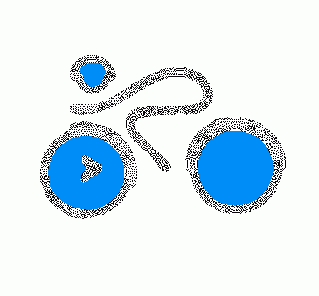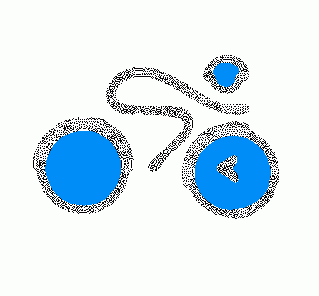| Newsletter - 2012 Archive |
 |
Cycling Club |
 |
| Newsletter - 2012 Archive |
 |
Cycling Club |
 |
Next--->
|
Defining the Allowable Support Zone Around a Control Stephen emphasizes that this is not official club policy. But it is certainly a helpful exploration of questions concerning control zones. [EF] I was recently asked by a new ride organizer about support at the control. What exactly does "at the control" mean? I've heard people say "within 3km"? What is allowed? When I rode PBP in 1987, the PBP rules allowed for support only within 3km of the control. However, the latest PBP rules use only the phrase at the control without any mention of 3 km. I'm not sure why the 3km rule has changed, but the original intent was to prevent support for riders in between controls (check the Rules section of the website for more information on support), yet to also provide enough room for support vehicles to find parking nearby. My experience in 2003 PBP would indicate that at some controls, 3km zone was simply not adequate, and support was creating traffic nightmares. Another problem with a 3km rule can be seen when using a generic "Your Choice" as the control. Where exactly do you measure the 3km from? Yes, you can provide a tighter definition of the location in the route sheet, but it can still be a problem if you want to give a rider some choice. Another scenario is where the control (say at a 24-hour convenience store) is at one end of town, but the hotel is at the far end of town, more than 3km away. And if its ok to travel 3km to the hotel, what is wrong with 3.5km? Also, if a rider is picked up at a control, and then driven to another support location (say a hotel many kilometres away), and then driven back to the control to resume the ride, does this constitute support outside of a control? Go back to first principles: riders are not to be supported between controls, because this gives some riders an advantage over other riders. Our sport is based on the principle of self-sufficiency. If we keep this in mind, then this opens the definition of at the control to the discretion of the organizer, keeping in mind the principle of not providing an advantage to a rider, and using 3km as a guide for the distance that defines the control boundary. In the case of the rider leaving the route by car, and later returning to the route at the departure point, this would constitute support outside of a control unless the departure point was a control. (See Understanding the No En Route Support Rule on the website for more information on this.) In another scenario, what about at a secret control? It's a secret control. You can't have personal support, even if the control volunteer is providing you support at other controls. However, the organizer may choose to allow support if it is equally provided to all riders. In another scenario, what about an information control? How does that affect this rule? First, let's understand information controls, and their purpose. A brevet is required to have a control at the extremities of the ride, and also averaging about every 50 to 100 km, depending on length. (See Routes and Checkpoints in the Ride Organizer's toolkit for more information on control locations.) Sometimes a control may not have a suitable location for a control, or the opening hours of the business are limited, and for small numbers of riders, especially at a distant control with long opening times, it is not feasible to provide a volunteer control. In these circumstances, an "information control" may be used. A secret question is placed on the control card (NOT on the route sheet which is published in advance, and therefore not secret!) and the rider must answer this skill-testing question to demonstrate arrival at the control. (For these circumstances, it is recommended that the first available staffed (ie open business) location be used like a secret control as a back-up.) Can we have support at these locations? Again, organizer's call, but there is no real reason why not. Indeed, why not talk the support vehicle into volunteering to staff the control for all riders? Another use of an information control is as an intermediate control, much like a secret control, that prevents a rider from short-cutting a route where an alternative road exists, but may be too close to a staffed control to warrant a full control. In this case, the information control is not a true control, and so any support at this location would violate the no en route support rule. - - - So in summary, it is up to the organizer to define the control zone where support is permitted. Just make sure that the policy is well understood by all riders and all support vehicles before the ride begins and that support meets our intent of no en route support. Stephen welcomes comments/feedback on the above. [EF]
-
October 22, 2012 |